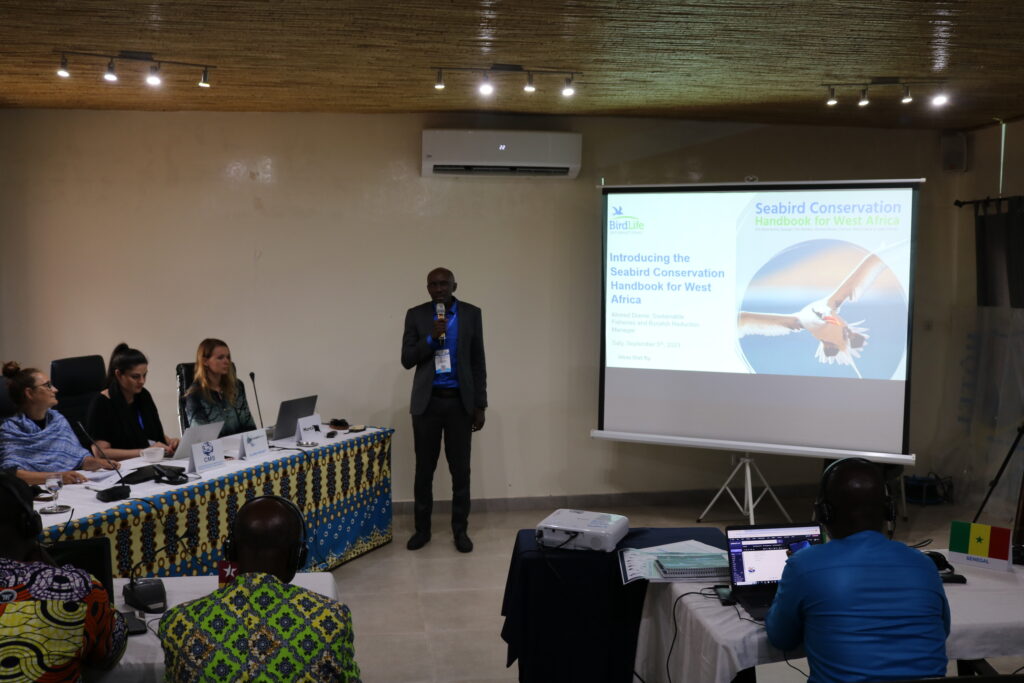Press Release: BirdLife launches Seabird Conservation Handbook for West Africa

The marine waters of West Africa's coast are highly productive, supporting numerous seabird species. However, these birds are threatened by bycatch, overfishing, climate change, their habitat destruction, and invasive alien species (IAS) among others.
BirdLife International yesterday launched the Seabird Conservation Handbook for West Africa, which provides up-to-date information on seabird distribution, threats, and conservation measures in key coastal sites in Mauritania, Senegal, The Gambia, Guinea- Bissau, Sierra Leone & Cabo Verde.
The launch took place on the sidelines of the Convention on Migratory Species (CMS) Marine Megafauna Week of the Atlantic Coast of Africa in an event that brought together decision-makers, governmental representatives, and international and regional non-governmental organizations from Africa and elsewhere. The handbook developed with the support of the MAVA Foundation and the UK Government Darwin Initiative, as part of the West Africa Marine Conservation Program which ran from 2010 – 2022 will be instrumental in advancing the conservation of seabirds in the region. Seabirds are among the most globally threatened group of birds. Statistics indicate that over 57% of the world’s 359 seabird species are in decline. Further, about 30% of the species are considered globally threatened, including 19 Critically Endangered 34 Endangered, and 58 Vulnerable, while a further 11% are listed as Near Threatened.
The marine waters of West Africa’s coast are highly productive, supporting numerous seabird species. However, these birds are threatened by bycatch, overfishing, climate change, their habitat destruction, and invasive alien species (IAS) among others. It is worth noting that bycatch is the 2nd leading cause of seabird deaths in the world, killing hundreds of thousands of birds every year, impacting populations of threatened species.
For a long time, the lack of accurate information including that on population trends, threats and effective measures, has hampered conservation efforts in West Africa. Since 2010, BirdLife has been involved in the collection of data on abundance and distribution of seabirds in the region. Moreover, data has been collected on threats to birds including of fisheries, and emergent oil and gas developments, in addition to the impacts of these threats to seabird colonies. Furthermore, BirdLife and its partners have been actively working on identifying and assessing marine IBAs (Important Bird and Biodiversity Areas).
This handbook will therefore be instrumental in providing an overview of the region’s seabirds, threats they face, and conservation tools and measures to help mitigate these threats. Closer collaborations between countries as well as experts and conservation organizations will be vital for effective seabird conservation. Further, the handbook will aid in the development of friendly conservation measures, in addition to marine research in the region. Entities planning fisheries or energy developments in the coastal zones of the region will also find the handbook useful in ensuring a win- win for conservation and sustainable development.
“The Seabird Conservation Handbook for West Africa provides the latest scientific data and information for the conservation of seabirds, including on the management of their threats, habitats, and key sites for conservation. This handbook is thus intended to inform and foster collaboration between all actors and decision-makers motivated by and involved in the conservation of seabirds in West Africa”, said Tabea Zwimpfer, BirdLife Africa Marine Coordinator.
“West Africa’s marine and coastal region is fundamental in supporting economies and livelihoods. But it is also vital for biodiversity, including seabirds, which play a unique role in the marine ecosystem. Yet, seabirds are under great pressure from a myriad of threats, and efforts are needed to ensure their continued survival in West Africa. The Seabird Conservation Handbook for West Africa introduces the key issues that seabirds face in the region and outlines steps for their conservation, including methods to monitor and study seabirds, and practical ways to protect them, illustrated through some actions that are already underway”, stated Tim Dodman, co-author of the handbook.
“The Seabird Conservation Handbook for West Africa is a collaborative effort between seabird experts, conservation organizations and supporting donors. This handbook plays a pivotal role in raising awareness among stakeholders and providing pragmatic solutions for effective seabird conservation efforts across West Africa. Safeguarding seabirds means safeguarding our marine resources and, consequently, our ways of life in West Africa. I am proud to say that another tool is now available. This handbook will contribute to the shift towards a more sustainable model that benefits both people and nature”, said Jean Baptiste Deffontaines, Deputy-Director of BirdLife International- Africa.
The Seabird Conservation Handbook for West Africa can be downloaded here
Header image: Ahmed Diame, Sustainable Fisheries & Bycatch Reduction Manager © BirdLife Africa

“The Seabird Conservation Handbook for West Africa provides the latest scientific data and information for the conservation of seabirds, including on the management of their threats, habitats, and key sites for conservation. This Handbook is thus intended to inform and foster collaboration between all actors and decision-makers motivated by and involved in the conservation of seabirds in West Africa.”
Tabea Zwimpfer, BirdLife Africa Marine Coordinator.